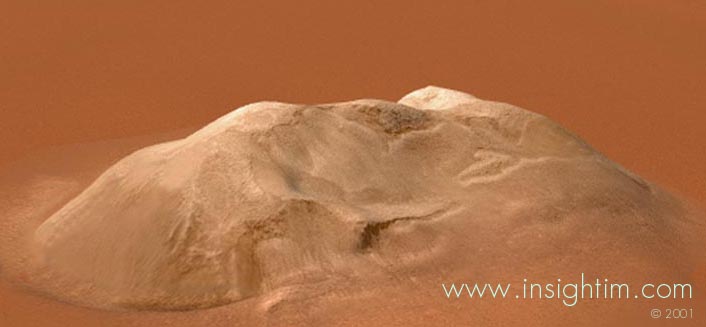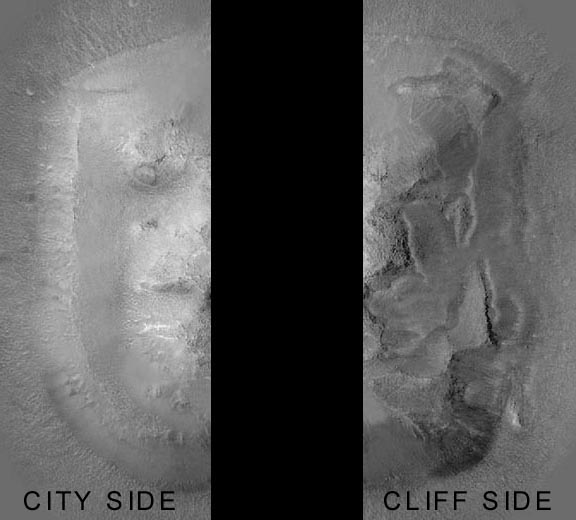Forensic Analysis of the Face on Mars
by KynthiaMany are familiar with the work of forensic artists from television shows such as "Quincy," or the more recent "CSI," experts who use their talents to reconstruct a face from just the anatomy of a skull. They do this by studying the shape of the skull and then extrapolating how the muscle tissue would attach to it and what the new surface areas would be like.
What we know about the Cydonia plateau is that during the Martian year, the prevailing winds — sometimes at over 300 miles per hour -- come sweeping out of the west, moving from direction of the City over the Face, heading eastward towards the Cliff.
When you examine this newest MGS image closely (E03-00824), it is easy to see this wind pattern. The City [left) side of the face appears significantly worn away, revealing a granular, etched surface looking very austere and gaunt.
|
Geologist Ron Nicks noted: |
Just over the crest of the Face’s nose (on the Cliff side), you can see the edges of what appears to be a "casing" (the "layering" that Ron Nicks talks about — see terrestrial examples below), where the original Face surface is obviously peeling away. Just below, in the ravines furrowing the Cliff side, are apparent deposits of material and debris flowing down slope from this higher up erosion (technically called "mass wasting").
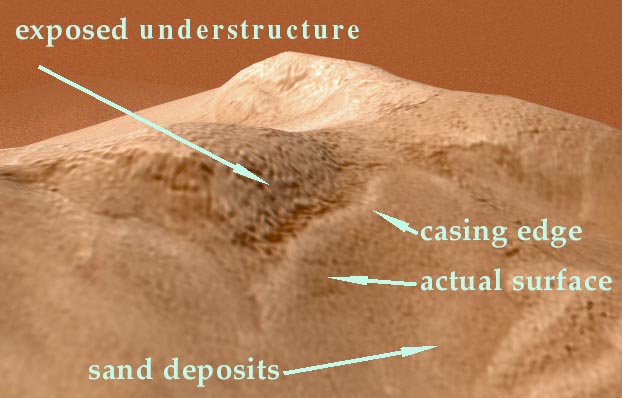
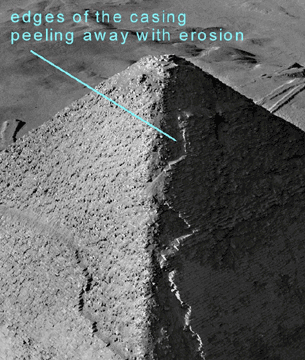
Based on abundant structural clues in the latest, high-resolution image, quite possibly (going back to our forensic model), when initially created, the City side of the Face had a fuller appearance. With time (how much time?!), this side — because of those relentless prevailing winds -- simply eroded away at a faster rate than the "protected" side, the side facing toward the Cliff. Look at the deterioration of our own Sphinx today, with a lifespan of a brief "moment" compared to the "250,000 years plus" estimated that the Face on Mars has stood against those winds. Surely, if five thousand years can do such extensive damage to the body of the Sphinx on Earth, so as to make portions of it devoid of detail and almost unrecognizable, what could we expect of an ancient "monument" abandoned on the windswept surface of the planet Mars for a hundred times as long ..? In fact, it's amazing that we see as much detail on the exposed side of the Cydonia Face as we do: nostrils on the nose, and even a surviving eyeball -- complete with under lid.

Also remember, the head of the Sphinx was apparently re-sculpted sometime during the time of Ancient Egypt, long after it had suffered extensive erosion damage somewhere in the mists of time on Earth (that’s why the head today is smaller and contains more detail than the body). If it were not for the anatomy of its overall morphology (shape and form), we would not even know the Sphinx was supposed to represent a human head married to a lion’s body.
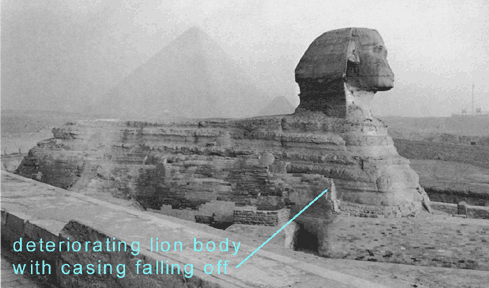
An identical Anatomy of Form is key to discovering the identity of the Martian enigma at Cydonia.
All of us have been to the beach and watched a child pouring sand over a friend until she is completely covered. You'll recall that you really can't make out the features and details of her body after such an exercise, which are rapidly lost underneath even a relatively thin blanket of overlying sand.
Just as the sand makes it all but impossible to discern the details of a child covered on the beach, likewise the deposits collecting for thousands of years on the leeward (downwind) side of the Face on Mars have obscured many anatomically important features toward the Cliff. There are however, in this latest image, some surviving elements that give us clues to what else "lies beneath those sands."
Without question, there is an underlying mental template to this "monument" we call the Face, an inherent structure (like the Sphinx on Earth) that creates a "decodable matrix" … giving us some very strong clues in this new image to its ultimate intended form.
